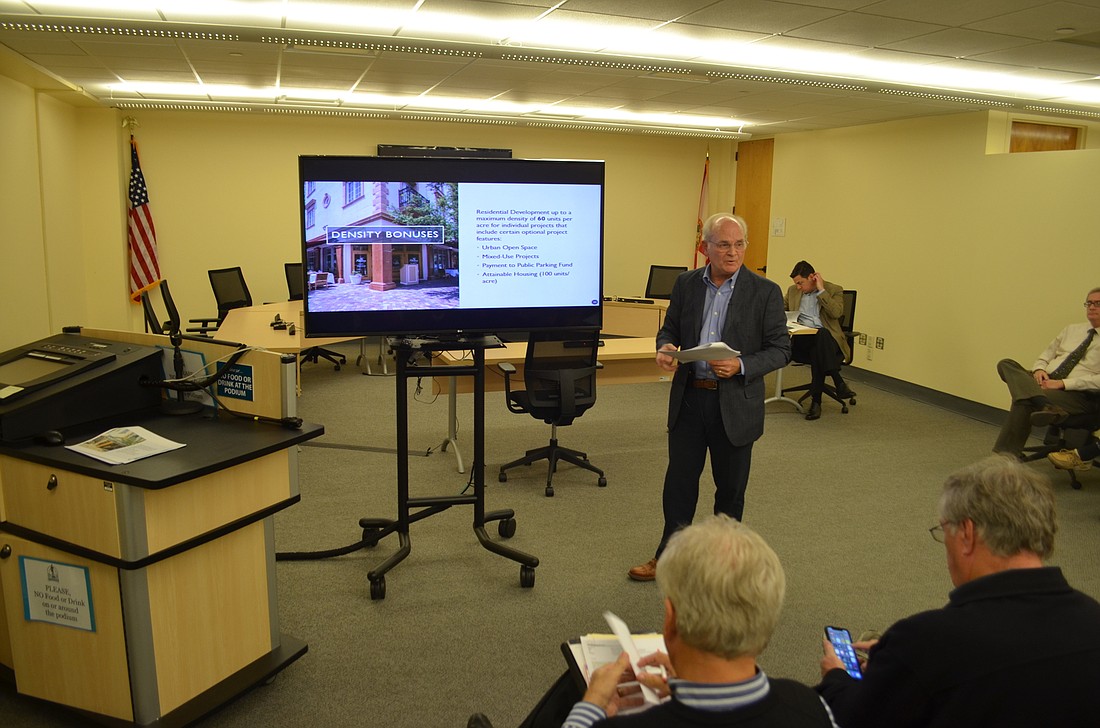- July 26, 2024
-
-
Loading

Loading

A series of proposed development regulations designed to foster quality growth in the Rosemary District received another vote of confidence March 7, though some critics questioned the sufficiency of the standards.
In a 4-1 vote, the city’s Planning Board recommended approval of changes to the Rosemary Residential overlay District, which applies to new buildings in the north-of-downtown neighborhood. Howard Davis, president of the Rosemary District Association, saw the decision as an endorsement of the work done to strike a balance between stimulating growth and addressing a rapidly developing neighborhood’s needs.
“There was an awful lot of thought given to a basic underlying premise, which is: How do we encourage additional investment in the Rosemary District, but do so in a way that ensures the new projects that are built also bring something to the community?” Davis said.
For more than three years, Rosemary District stakeholders have been engaged in a community conversation about how to address issues that have arisen during an ongoing building boom in the area. The spike in development is tied to the 2014 establishment of the Rosemary Residential Overlay District, which increased the maximum density of individual projects from 25 residential units per acre to 75 units per acre.
The overlay district, which spurred the approval of more than 1,500 new units in the neighborhood, sunset at the end of 2018. Ahead of the expiration of the density bonus, neighborhood leaders sought to preserve the good aspects — the revitalization of a struggling neighborhood — while addressing the bad, such as undesirable project design and a lack of affordable housing.
The proposed solution? Tying the increased density to higher building standards designed to improve the neighborhood. The baseline density in the neighborhood would increase to 40 units per acre, but all projects would need to comply with new regulations mandating wider sidewalks, varied facades and more.
If a developer wanted more density, building a mixed-use project or making contributions toward neighborhood green space or parking could lead to up to 60 units per acre. If developers provide affordable housing, they could get up to 100 units per acre.
Although the Planning Board had questions about the plan, the majority saw the proposal as an improvement over both the original overlay district and the zoning in place before 2014. The lone dissenting vote came from a member who feared the changes wouldn’t do enough to ensure new developments provided benefits for the neighborhood.
Architect Damien Blumetti asked Davis and city staff what would happen to the neighborhood if developers opted not to take advantage of the incentives, instead building the 40 units per acre allowed by right.
“For me, the worst-case scenario is actually that happening,” Blumetti said. “The fact that’s a possibility is a bit concerning.”
Blumetti wasn’t the only one to raise concerns about the sufficiency of the incentives. Architect Michael Halflants, whose studio is located in the Rosemary District, suggested developers had no reason to build affordable housing units in exchange for more density within the same building footprint. Halflants said the increased density would just require the developer to build smaller units, decreasing the average sale price.
Halflants advocated for a higher baseline density to encourage the construction of smaller units, fearing the proposed changes would lead to rising prices in the neighborhood. Otherwise, he said, said developers would likely rather sell fewer, more expensive units rather than voluntarily provide affordable housing for the right to build more, cheaper units.
"Bigger units are easier to build," Halflants wrote in a paper criticizing the proposal. "They require fewer kitchens, fewer parking spaces and fewer entry doors."
Last year, the city helped commission a Blueprint for Workforce Housing as part of a quest to address a regional shortage of affordable housing. That document, crafted by the Florida Housing Coalition, criticized previous affordable housing initiatives in Sarasota for not including forceful enough regulations. City staff said the proposed Rosemary District regulations included a requirement for long-term affordability, as recommended in the Blueprint for Workforce Housing.
Based on the conversations with neighborhood stakeholders, staff did not feel comfortable recommending an inclusionary housing policy, which would require the construction of affordable housing units rather than provide incentives. The Blueprint for Workforce Housing recommended, at minimum, the city create inclusionary housing standards for large residential developments.
Davis said the group that crafted the proposal considered an inclusionary zoning system. He acknowledged it can be an effective tool, but because inclusionary zoning is not in place elsewhere in the city, he expressed concern that higher standard would discourage investment in the neighborhood. He said the higher building standards for the baseline density were designed to ensure all projects carried at least some public benefit.
Although there are some vocal advocates for higher density, Davis said adjusting the proposal could invite opposition from some residents who fear the prospect of more units in the neighborhood. Davis said the support for the proposal made him feel comfortable the changes struck a good balance.
“Is it going to be the solution to attainable housing in and of itself?” Davis said. “Probably not. Is it a big step forward from what we have anywhere else in Sarasota? Absolutely.”
The revised overlay district is scheduled to go before the City Commission in May. Because the changes would require an amendment to the comprehensive plan, a supermajority of four commissioners must support the proposal for it to advance. Based on the reaction he’s seen so far, Davis remains confident the regulations would result in a better future for the Rosemary District.
“It’s moving forward on multiple fronts, none of which will be the definitive answer to the challenges the neighborhood faces,” Davis said. “All of which, though, will be movement in the right direction.”